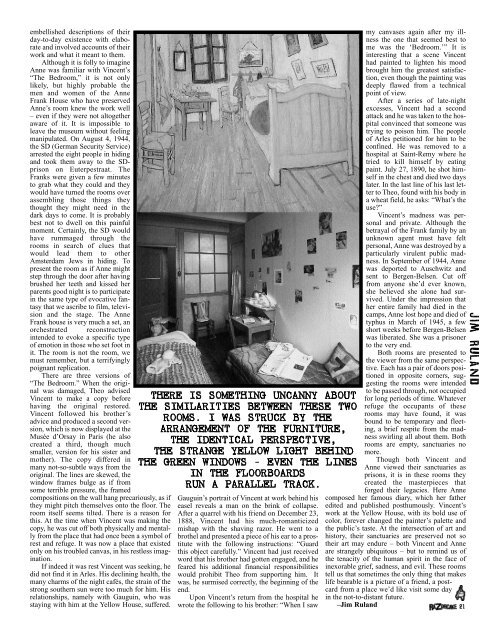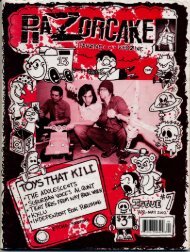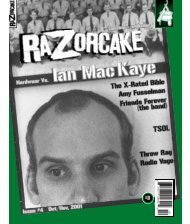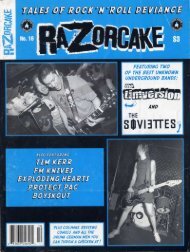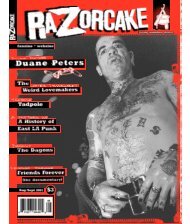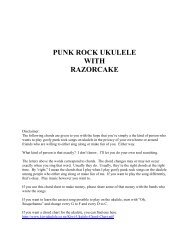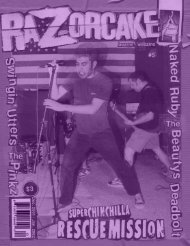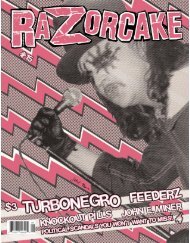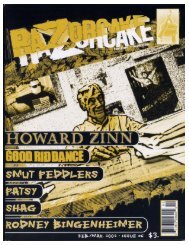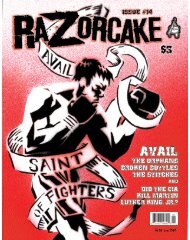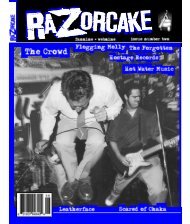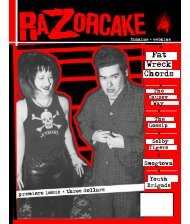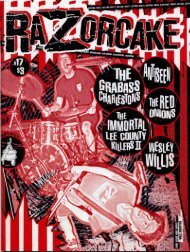JIM RULANDLAZY MICKJIM RULANDVINCENT'S MADNESS WAS PERSONAL AND PRIVATE. ALTHOUGH THE BETRAYALOF THE FRANK FAMILY BY AN UNKNOWN AGENT MUST HAVE FELT PERSONAL,ANNE WAS DESTROYED BY A PARTICULARLY VIRULENT PUBLIC MADNESS.SANCTUARIESA few summers ago I went to Amsterdam forall the usual reasons. I thought the highlight ofmy trip would be sitting in the Old Sailor Bar,sipping stout while high on hash, watchingEnglish football hooligans work up the nerve toproposition the prostitutes behind the glass onthe other side of the alley. What I didn’t expectwas to be swept up in two of the city’s most populartourist destinations: the Anne Frank Houseand the Vincent van Gogh Museum.Ironically, Anne’s house is easy to miss.Like the other canal-side houses onPrinsengracht, the Anne Frank House is tall andnarrow, more deep than wide. The museum hasexpanded since it opened in 1960. A new structurehas been added to the offices and warehousethat sheltered the secret annex where Anne andseven others hid from July 6, 1942, throughAugust 5, 1944. It is not an ostentatious building.Extensive renovations have camouflagedthe museum’s façade. The result is subtle andinnocuous. If it weren’t for tourists queued outsidethe entrance, I might not have realized itwas there at all.To reach the annex, one has to navigate thereconstructed rooms where Otto Frank workedas a buyer and seller of spices. The visitor movesthrough dreary offices and storerooms, past rowsof empty desks and stacks of tins used for measuringthe spices that were ground on thepremises. At the secret entrance to the annexproper, the movable bookcase is left proppedopen and the effect is reminiscent of a hauntedhouse, a scene from a Nancy Drew novel.Ascending the tight, narrow staircase, the wealthof information about Mr. Frank’s business I havejust absorbed strikes me as irrelevant. The creakingstairs tell as much as the plaques and typednote cards in the display cases. Unlike mostfamous homes that have been converted intomuseums with their roped-off rooms like a preciousfull-scale diorama, the visitor’s experienceat the Anne Frank house is intimate and intense.Eight people hid here for over two years. Theseare the rooms.No space appears more lived in than Anne’sbedroom, which she shared, first with her sisterMargot and then with Fritz Pfefferan, a middleageddentist who had gone into hiding with theFranks. It is very much a child’s room. Themuseum’s curators have taken great pains togive the room a lived-in look.20A dressing gown hangs from a hook. A piece offlimsy fabric is draped over a chair. A replica ofAnne’s journal sits on the desk. The soft lightfrom the desk lamp suggests a writer at work. Itis a room that is always awaiting Anne, butAnne, of course, is never coming back.The Anne Frank House is the second mostpopular tourist attraction in Amsterdam; theVincent van Gogh Museum is the first. Themuseum was at the top of my list of things to doin Amsterdam, and it was a crushing disappointment.Standing before van Gogh’s“Sunflowers,” I felt as if someone was playinga trick on me. I didn’t see the specialness of theart on display, even though I wanted to. Lookingat the painting, I felt I understood it entirely. Noweird symbolism to grasp. No half-formed figuresto pretend to understand. Growing up on afarm, Vincent was no stranger to sunflowers,and yes, these were indeed sunflowers, but theydidn’t strike me as a particularly competentdepiction. Look at all the paint he used. It lookslike he smeared it on with a trowel. Clearly, hewants it to be more complicated than it is.In the bookstore I bought a short biographyof Vincent van Gogh, complete with a treatise ofhis works. I took the book to the Hard RockCafé. The rain had abated; the sun had comeout, glinting brightly in the puddles on the sidewalk.I ordered a Heineken and read aboutVincent taking up with prostitutes, drinkingabsinthe, roaming the streets of Paris with a pistolin his pocket. No question about it, he was acrazy motherfucker. I turned the page and spieda photo of a composition called “TheBedroom,” and my head started to spin. Itdepicts a small, close room in the south ofFrance. The room, or rather Vincent’s representationof it, bore an eerie similarity to Anne’sbedroom in the annex. I hauled out a post cardI’d purchased at the Anne Frank Museum andcompared the two rooms. I was floored by thesimilarities.While the actual rooms were separated byover sixty years and nearly 800 miles, the tworepresentations – one a reconstruction, the othera visual composition – have been broughttogether in Amsterdam and are separated by abrisk walk across the city. There is somethinguncanny about the similarities between thesetwo rooms. I was struck by the arrangement ofthe furniture, the identical perspective, thestrange yellow light behind the green windows– even the lines in the floorboards run a paralleltrack. Though the two are not usually associatedtogether, if Anne is Amsterdam’s best knowndaughter, Vincent is the city’s favorite son.The thing about Vincent van Gogh is we arefascinated with him for all the right reasons: hisviolent outbursts, the savage self-immolationand, ultimately, his spectacular suicide, whichwas foretold in his last work in oils, “Crows inthe Wheatfield.” His notoriety outshines hismost well known work; his creations are foreverfixed in his Promethean shadow. Perhaps it’s allthose self-portraits. Maybe Kirk Douglas’s portrayalin Lust For Life has something to do withit, giving birth to the myth of Vincent as a broodingRomantic, a misanthropic genius, the proteanBeat who cared more about ideals thanfilthy lucre.In 1888 Vincent fled to Arles where he rentedrooms in the now famous Yellow House at 2Lamartine Place. He went to work on new projectsremarkable for their bold use of color. Both“Sunflowers” and “The Bedroom” are from thisperiod. This is Vincent’s description of the latter:This time it’s just simply my bedroom, onlyhere color is to do everything, and giving by itssimplification a grander style to things, is to besuggestive here of rest or of sleep in general. Ina word, to look at the picture ought to rest thebrain or rather the imagination.A study of these near identical rooms leadsthe viewer’s eye to the pictures Anne pasted onthe wall above her bed and writing desk, andthose that decorate the walls of Vincent’s painting.The photos Anne glued to the wall are stillthere, preserved behind glass. The Canadianfilm star Deanna Durbin seems to have been afavorite. Words from Anne’s famous diary providesan indication of her motive:Our little room looked very bare at first withnothing on the walls; but thanks to Daddy whohad brought my picture postcards and film-starcollection on beforehand, and with the aid ofpaste pot and brush I have transformed the wallsinto one gigantic picture. This makes it lookmuch more cheerful. (July 11, 1942)Anne’s description would have delightedVincent. His walls were decorated with his ownwork, among them portraits of the poet EugèneBoch and the soldier Paul-Eugène Milliet. It ispleasing to think that if Anne had seen Vincent’sbedroom, she would have recognized the roomfor what it was – a place of refuge, a sanctuary.The Diary of Anne Frank is something of amisnomer. Anne’s diary is really a series of lettersaddressed to an imaginary friend namedKitty, her sister, if you will, of the imagination.Vincent’s letters to his brother possess the intimacyof a diary and some take them as a form ofautobiography. “I can write no differently than Ido,” he told his brother. Both Vincent and Anne
embellished descriptions of theirday-to-day existence with elaborateand involved accounts of theirwork and what it meant to them.Although it is folly to imagineAnne was familiar with Vincent’s“The Bedroom,” it is not onlylikely, but highly probable themen and women of the AnneFrank House who have preservedAnne’s room knew the work well– even if they were not altogetheraware of it. It is impossible toleave the museum without feelingmanipulated. On August 4, 1944,the SD (German Security Service)arrested the eight people in hidingand took them away to the SDprisonon Euterpestraat. TheFranks were given a few minutesto grab what they could and theywould have turned the rooms overassembling those things theythought they might need in thedark days to come. It is probablybest not to dwell on this painfulmoment. Certainly, the SD wouldhave rummaged through therooms in search of clues thatwould lead them to otherAmsterdam Jews in hiding. Topresent the room as if Anne mightstep through the door after havingbrushed her teeth and kissed herparents good night is to participatein the same type of evocative fantasythat we ascribe to film, televisionand the stage. The AnneFrank house is very much a set, anorchestrated reconstructionintended to evoke a specific typeof emotion in those who set foot init. The room is not the room, wemust remember, but a terrifyinglypoignant replication.There are three versions of“The Bedroom.” When the originalwas damaged, Theo advisedVincent to make a copy beforehaving the original restored.Vincent followed his brother’sadvice and produced a second version,which is now displayed at theMusée d’Orsay in Paris (he alsocreated a third, though muchsmaller, version for his sister andmother). The copy differed inmany not-so-subtle ways from theoriginal. The lines are skewed, thewindow frames bulge as if fromsome terrible pressure, the framedcompositions on the wall hang precariously, as ifthey might pitch themselves onto the floor. Theroom itself seems tilted. There is a reason forthis. At the time when Vincent was making thecopy, he was cut off both physically and mentallyfrom the place that had once been a symbol ofrest and refuge. It was now a place that existedonly on his troubled canvas, in his restless imagination.If indeed it was rest Vincent was seeking, hedid not find it in Arles. His declining health, themany charms of the night cafés, the strain of thestrong southern sun were too much for him. Hisrelationships, namely with Gauguin, who wasstaying with him at the Yellow House, suffered.THERE IS SOMETHING UNCANNY ABOUTTHE SIMILARITIES BETWEEN THESE TWOROOMS. I WAS STRUCK BY THEARRANGEMENT OF THE FURNITURE,THE IDENTICAL PERSPECTIVE,THE STRANGE YELLOW LIGHT BEHINDTHE GREEN WINDOWS - EVEN THE LINESIN THE FLOORBOARDSRUN A PARALLEL TRACK.Gauguin’s portrait of Vincent at work behind hiseasel reveals a man on the brink of collapse.After a quarrel with his friend on December 23,1888, Vincent had his much-romanticizedmishap with the shaving razor. He went to abrothel and presented a piece of his ear to a prostitutewith the following instructions: “Guardthis object carefully.” Vincent had just receivedword that his brother had gotten engaged, and hefeared his additional financial responsibilitieswould prohibit Theo from supporting him. Itwas, he surmised correctly, the beginning of theend.Upon Vincent’s return from the hospital hewrote the following to his brother: “When I sawmy canvases again after my illnessthe one that seemed best tome was the ‘Bedroom.’” It isinteresting that a scene Vincenthad painted to lighten his moodbrought him the greatest satisfaction,even though the painting wasdeeply flawed from a technicalpoint of view.After a series of late-nightexcesses, Vincent had a secondattack and he was taken to the hospitalconvinced that someone wastrying to poison him. The peopleof Arles petitioned for him to beconfined. He was removed to ahospital at Saint-Remy where hetried to kill himself by eatingpaint. July 27, 1890, he shot himselfin the chest and died two dayslater. In the last line of his last letterto Theo, found with his body ina wheat field, he asks: “What’s theuse?”Vincent’s madness was personaland private. Although thebetrayal of the Frank family by anunknown agent must have feltpersonal, Anne was destroyed by aparticularly virulent public madness.In September of 1944, Annewas deported to Auschwitz andsent to Bergen-Belsen. Cut offfrom anyone she’d ever known,she believed she alone had survived.Under the impression thather entire family had died in thecamps, Anne lost hope and died oftyphus in March of 1945, a fewshort weeks before Bergen-Belsenwas liberated. She was a prisonerto the very end.Both rooms are presented tothe viewer from the same perspective.Each has a pair of doors positionedin opposite corners, suggestingthe rooms were intendedto be passed through, not occupiedfor long periods of time. Whateverrefuge the occupants of theserooms may have found, it wasbound to be temporary and fleeting,a brief respite from the madnessswirling all about them. Bothrooms are empty, sanctuaries nomore.Though both Vincent andAnne viewed their sanctuaries asprisons, it is in these rooms theycreated the masterpieces thatforged their legacies. Here Annecomposed her famous diary, which her fatheredited and published posthumously. Vincent’swork at the Yellow House, with its bold use ofcolor, forever changed the painter’s palette andthe public’s taste. At the intersection of art andhistory, their sanctuaries are preserved not sotheir art may endure – both Vincent and Anneare strangely ubiquitous – but to remind us ofthe tenacity of the human spirit in the face ofinexorable grief, sadness, and evil. These roomstell us that sometimes the only thing that makeslife bearable is a picture of a friend, a postcardfrom a place we’d like visit some dayin the not-to-distant future.–Jim Ruland 21JIM RULAND


